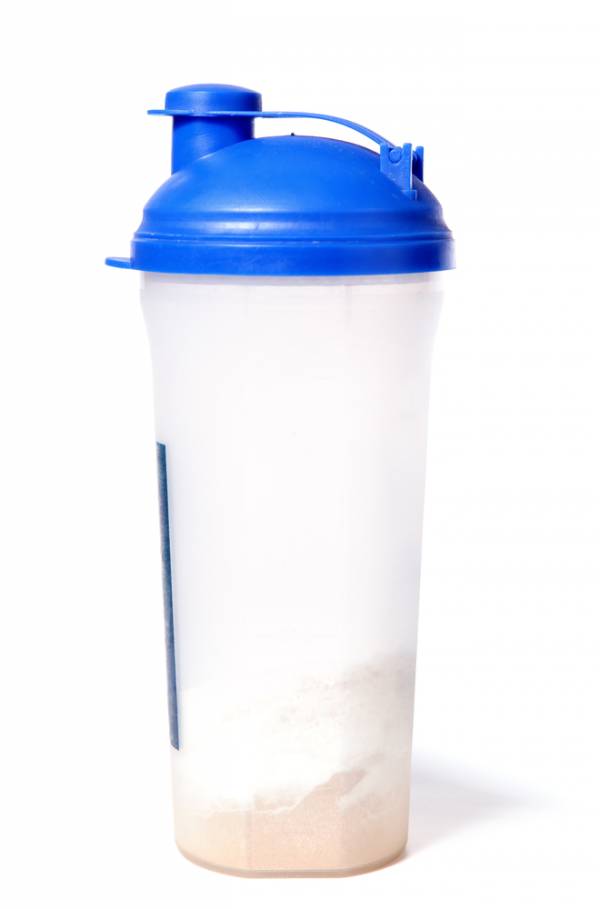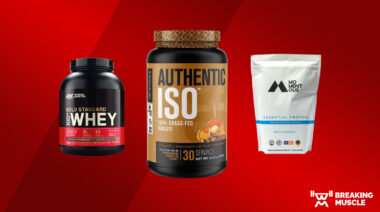It’s no surprise that if you lead an active lifestyle you’ve probably downed a protein shake or two. Whether you’ve
read about why you should drink them or actually consumed them, you’re well aware they should be a part of your exercise regimen. Because the business of protein supplements has become so lucrative, there is much competition between these products. This is why looking at the great wall of supplements can be pretty intimidating. Yes, that pit in your stomach is normal when cowering down before the eighty million selections.
“GET BUILT TOMORROW!”
“Made with protein, designed with love.”
“Inexpensive and conveniently premixed for your busy life.”
These aren’t exact labels, but they are close to some of the marketing geared to get your green. Arguably, you should be consuming what works best for you. Sometimes that does mean going with the “Beefcake Builder.” Other times you may want to pick up a four-pack of “Cheap and Easy.” But of those selections you may want to be leery of their contents.
This starts the debate of whether premixed supplements or powder (self-made) supplements are better for you. Before making declarations and waiving our all-knowing flags, it’s vital to understand each side individually.
Premixed Protein Supplements
There is no disputing. These. Are. Awesome. Premixed shakes are usually in a perfect serving size to quench your post-gym thirst. They generally taste delicious and come in an assortment of flavors. Most importantly, the manufacturers have already included the nutrients they think belong in your protein shake. That is also a problem.
While these are the easiest shakes to buy, you also have the least control over what you’re ingesting. For some, having someone else responsible for that is an attractive quality. But for those of you who don’t trust the FDA one hundred percent that could raise some concern.
The key factors you want to examine when purchasing premixed shakes are:
- Protein content (this should be comparable to other supplements)
- Carbohydrate content (this should be higher)
- Ingredient List (what the heck are you drinking, anyway?)
Protein Content:
This is obviously important because it’s the reason you’re purchasing the product! If you’re paying six dollars for a four-pack and each shake only contains eight grams of protein, keep searching. You aren’t getting your money’s worth and even Greek yogurt has more protein in it than that. Plus, yogurt is delicious and cheaper so you might as well stick to going Greek.
Carbohydrate Content:
So you just beat yourself to a pulp. You lifted weights like the Hulk and sprinted like the Hulk was chasing you. When you head home you need to replenish all of that expended energy quickly and efficiently. You can do this by consuming high-carb and high-sugar shakes because your body won’t abuse them in ways it normally might. What I mean is after a workout is when your body is using sugar and carbs effectively and is less likely to convert it to fat, but rather use it to avoid falling into a fainting spell.
Ingredient List:
Arguably the most important aspect. Sure it contains calcium, protein, and some fat, but what did they use to get that in there? Products are approved by the FDA, but not all the ingredients have to be disclosed if they are under a certain amount. Sorry, I don’t care if there is only .6% of animal waste, I don’t really feel up to that.*
(*Not an actual ingredient…I hope).
In a report released by Consumer Reports, a test was run on approximately fifteen, premixed and powder supplements. In the study they found traces of heavy metals in the products. Most had very little but there were three popular and well-known brands that contained dangerously high amounts.
The chart they created was based off of a three serving test but if you consumed three shakes per day, you would surpass the daily maximum levels using several of the products. The products that carried the highest or most lethal amounts of arsenic, cadmium and lead were:
- EAS Myoplex Original Dark Chocolate Shake (liquid)
- Muscle Milk Chocolate (powder)
- Muscle Milk Vanilla Crème (powder)
Notice that two of the supplements are the powder mixes. Uh oh, weren’t expecting that curve ball, were you? Before you toss your Cake Batter Muscle Milk drinks, let’s fairly examine powder or self-made protein shakes first.
Powder Protein Supplements
 Calling powder protein supplements “self-made” is kind of an oxymoron. If it was really self made you would be skimming the whey from the cow’s teat and drying it into a powder. You are not doing that – this is America after all.
Calling powder protein supplements “self-made” is kind of an oxymoron. If it was really self made you would be skimming the whey from the cow’s teat and drying it into a powder. You are not doing that – this is America after all.
Sure, powder protein supplements (PPS, because that’s too much to keep typing) let you decide what you will mix it with. You can choose water, dairy milk, almond milk, soymilk, or any liquid you think will mix well with it. You can add peanut butter or a banana. You can be a self-proclaimed physicist of PPS if you want. Go crazy.
But at the end of the day there is no disputing the powder was made for you. As careful as you must be about premixed drinks, you have to be equally as inquisitive over powder.
As the chart showed, two of the three supplements tested were in powder form. But don’t throw in the towel just yet – it is still safe to drink powder, but just do some research first. In a time where so much of our food is genetically altered or created with more fluff than we need, you should be the Sherlock Holmes of your nutritional life. This includes protein supplement consumption.
Here’s another shocker. Just because it’s dry doesn’t mean you shouldn’t examine the same items as premixed drinks: protein content, sugar content, and ingredient list. Even if all of those check out, make sure there isn’t a strange or high-level of an unidentifiable ingredient.
It’s okay. Come out from under the covers, the monsters are gone. Protein supplements exist because after depleting your body of nutrients, hydration, minerals, energy, and protein, liquid is the quickest way to revitalize your aching physique. It allows you to absorb everything you need very quickly and help your body repair itself.
With that, however, it’s safe to say that the right selection is…to be in control. That’s right. This is a variation of the two, fused into the perfect answer.
Using protein powders can be effective, but so is using natural proteins. These would be foods such as yogurt, beans, eggs, lean meats, and vegetables. I know, not all of these will taste good in blender, but try adding apples to your shake along with a scoop of carefully researched protein powder. Some very good and reputable proteins powders are available at your local GNC, Vitamin Shoppe, or even grocery store and won’t break your bank.
Powders to consider would are:
- Whey Protein – Derived from cheese production and quickly digested.
- Organic Protein – Some whey protein powders are considered organic as well, which offers an all-natural approach.
- Casein Protein – Slowly digested, but may act as a benefit to sustain protein consumption over longer period of time.
Reverting back to being a scientist will be the safest and most effective way to consume protein. This will leave you in control of what you’re consuming and ultimately, you to blame if something goes awry. Only kidding!






